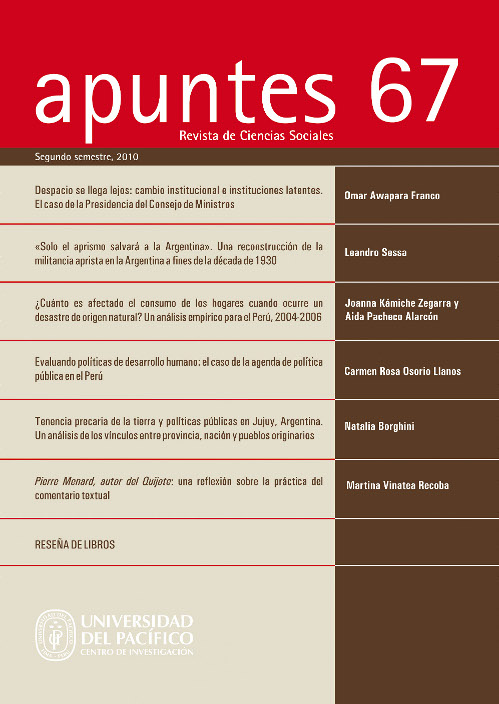How much is affected the consumption of the homes when a disaster occurs in natural origin? An empirical analysis for Peru, 2004-2006
DOI:
https://doi.org/10.21678/apuntes.67.609Keywords:
Natural disasters, consumption, economy, PeruAbstract
Between 2004 and 2009, 63% of emergencies that took place in Peru were caused by natural-related events and generated a negative impact on the incomes and/or assets of households affected. Not withstanding, there are nosurveys in the country that analyze the direct economic cost that such events represent to households.
This research –through the estimate of change in consumption generated by the occurrence of a natural-related event– quantifies the economic cost that represents loss of assets and/or income, caused by the emergency to households. For the purpose thereof, with panel information of the Enaho for years 2004 and 2006, Impact Evaluation Methodologies are applied: before and after and double difference (with a control group), which allows determining that households affected by disasters lose between 4,5% (average value) and 11,0% (median value) of total consumption after the occurrence of the event. The research also concludes that vulnerability variables due to fragility (condition of roof and walls) and resilience (education level and age of head of household) explain the negative changes in consumption generated by a natural related disaster.
Downloads
Downloads
Published
How to Cite
Issue
Section
License
Apuntes publishes all its articles and reviews under a Creative Commons Attribution (CC BY 4.0) license with the objective of promoting academic exchange worldwide. Therefore, articles and book reviews can be distributed, edited, amended, etc., as the author sees fit. The only condition is that the name of the author(s) and Apuntes. Revista de Ciencias Sociales (as the publisher) be cited.



.jpg)
